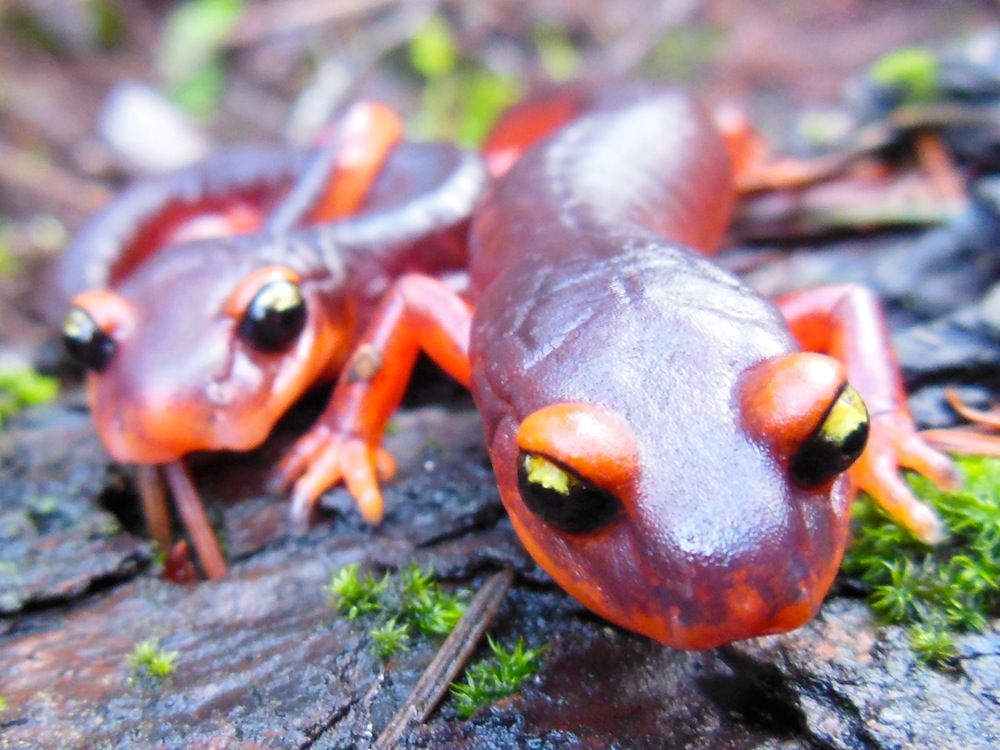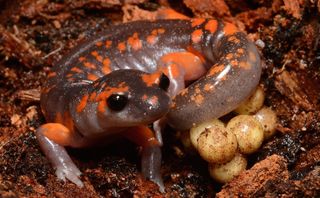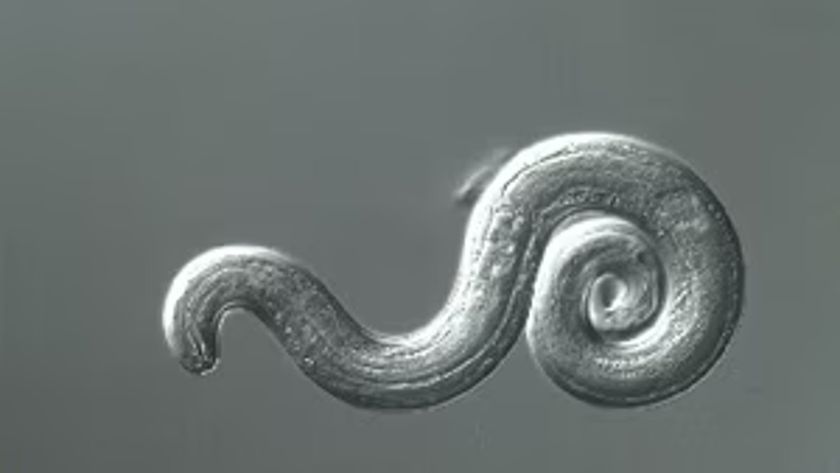Deadly Fungus Could Threaten US Salamanders

Each year, thousands of live salamanders arrive in shipments on U.S. shores, a trade that must stop immediately, scientists say.
According to new research, a ban on salamander imports is crucial to stopping the spread of a deadly fungus that kills almost every salamander it infects. Batrachochytrium salamandrivorans, also known as Bsal, is a chytrid fungus, and a close relative of Batrachochytrium dendrobatidis (Bd), a frog fungus that is threatening species worldwide.
Bsal was first discovered in 2013 after fire salamanders in the Netherlands began dying in droves. Since then, the fungus has appeared in Belgium. Bsal originated in Asia, researchers have found, and spreads via the pet trade. [Album: Bizarre Frogs, Lizards and Salamanders]
It's that trade that puts North America at risk, researchers report today (July 30) in the journal Science. The continent is the global center for salamander diversity; 48 percent of all known salamander species live in North and Central America. Among these species are those most vulnerable to Bsal.
"This is the hot bed in the world for diversity of amphibians, and if that fungus gets here, it's going to be devastating," said study author Vance Vredenburg, a biologist at San Francisco State University.
Saving the salamanders
The story of the frog fungus Bd foreshadows the high stakes for North American salamanders. That fungus kills its froggy victims by invading their skin and thickening it. Because amphibians absorb water through their skin, the infection causes dehydration, electrolyte imbalance and eventual cardiac arrest.
Sign up for the Live Science daily newsletter now
Get the world’s most fascinating discoveries delivered straight to your inbox.
Bd acts rapidly. In the Sierra Nevada mountains, the fungus killed 75 percent of the mountain yellow-legged frog population in a mere four years. The disease has also spread worldwide; In February, researchers wrote in the journal Scientific Reports that Bd has been found in Madagascar, an island long thought free of the disease.
"I've just seen devastation on a scale that is unbelievable, tens of thousands of animals dying in front me," Vredenburg, who has studied Bd for decades, told Live Science.
Bsal appears to be similarly devastating. The fungus is widespread in Asia, where amphibians don't appear susceptible to the infection's effects. But when salamander populations that didn't evolve alongside the fungus are exposed for the first time, the results are catastrophic. In Europe, the fatality rate among infected salamanders is about 96 percent, previous study has found.

Stopping the spread
Fearing that Bsal may soon land on North American shores, Vredenburg and his colleagues mapped out the regions where the Asian salamanders that carry the fungus are likely to find welcoming habitats. Next, the researchers combined that map with a measure of species richness, or how many salamander species live in each region.
The combined data revealed three spots that are particularly at risk because they're both high in salamander diversity and welcoming to the foreign carriers of the fungus: the southern United States, including the hot spot of diversity in the southern Appalachian Mountains; the highlands of Central Mexico; and the Pacific Northwest and Sierra Nevada Mountains.
These areas are home to many salamanders from the Plethodontidae and Salamandridae families, which are particularly vulnerable to Bsal infection, the researchers report. North American newts, which are in the Salamandridae family, have a 100 percent mortality rate when infected with Bsal in lab tests, researchers reported in 2013 in the journal Proceedings of the National Academies of Science. [Alien Invaders: Destructive Invasive Species]
The top U.S. ports for live salamander imports are alarmingly close to several of these hot spots, and 99 percent of the salamanders these ports trade hail from Asia, home to the chytrid fungus. Between 2010 and 2014, the researchers found, 768,572 salamanders potentially carrying Bsal arrived in U.S. ports. The top points of entry were Los Angeles; Tampa, Florida; New York; Atlanta; and San Francisco. (There were 779,002 salamanders imported in total during that time, with slightly more than 10,000 not carrying a risk of Bsal.)
"Atlanta and San Francisco really stood out as being in highly vulnerable zones," Vredenburg said.
Predicting exactly how and where Bsal might hit is a difficult task, warned Karen Lips, a biologist at the University of Maryland who has been involved in efforts to stop the fungus, but who did not take part in the current report. Vredenburg and his colleagues have made a good approximation, Lips told Live Science, but basic information about Bsal remains scarce.
"We don't know all the species that this thing can infect. That's one of the big problems," Lips said. "We also really don't know the details of the temperature requirements [for the fungus' spread], and we have no idea how the biology of the animals and the temperature and moisture requirements all interact." [7 Devastating Infectious Diseases]
Vredenburg and his colleagues are calling for the U.S. Fish and Wildlife Service (USFWS) to immediately ban live salamander imports. The agency is very concerned about the potential spread of Bsal, USFWS spokesman Laury Marshall Parramore told Live Science. However, the Lacey Act, which allows for the agency to forbid the importation and interstate transport of injurious species, does not have a provision for emergency listings, Parramore said.
"We are working with colleagues from federal and state government agencies, academic institutions, industry, and nongovernmental organizations to find innovative solutions to the problem," she said.
The Lacey Act is a century old and applies only to vertebrate animals, Lips said. It wasn't built to contain fungi, parasites or even invertebrates like invasive worms. Lips is part of efforts to get new laws on the books that would allow for better control and testing for disease in imported wildlife.
"Having gone through the Bd story, we know this is something that we need to be concerned about," Lips said. "We need to take this seriously, and we need to do everything we can now to prevent its introduction."
Vredenburg recommends that concerned citizens avoid buying Asian salamanders and urge their representatives to take action to regulate the foreign pet trade. People with amphibious (or reptilian) pets should never release them into the wild, he added.
"When people think they're releasing these animals into a nice little home somewhere, what they don't realize is they're also releasing all the pathogens and symbiotes that go with them," he said.
Follow Stephanie Pappas on Twitter and Google+. Follow us @livescience, Facebook & Google+. Original article on Live Science.

Stephanie Pappas is a contributing writer for Live Science, covering topics ranging from geoscience to archaeology to the human brain and behavior. She was previously a senior writer for Live Science but is now a freelancer based in Denver, Colorado, and regularly contributes to Scientific American and The Monitor, the monthly magazine of the American Psychological Association. Stephanie received a bachelor's degree in psychology from the University of South Carolina and a graduate certificate in science communication from the University of California, Santa Cruz.


